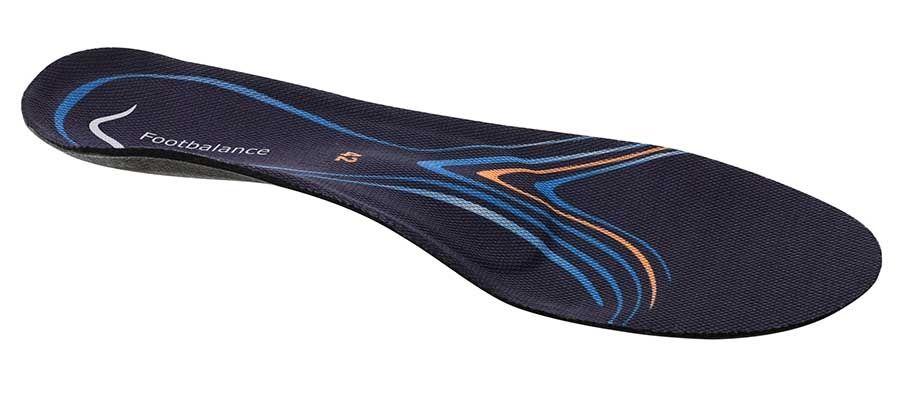Support (or “Sport”) Insoles
These feature a harder material for structural support and stability. Comfort is derived from the increased stability rather than direct cushioning.Supportive insoles are best for the following conditions:
- Structural misalignment, which can manifest not only as foot pain, but discomfort in the ankles, knees hip, back, neck or head.
- Plantar fasciitis: Medical professionals routinely recommend the use of a supportive insole as part of the treatment protocol for this painful condition resulting from tears in the plantar fascia—a band of connective tissue which connects the heel to the forefoot.
- Supination or over-pronation: Support insoles moderate a tendency for the feet to either supinate (roll out) or overpronate (excessive rolling in) when walking or running.
Insole Volume
Insoles can change footwear volume, which is the internal space of the shoe. High-volume insoles best suit high-volume shoes such as hiking boots, ski boots or running shoes.Low-volume insoles are needed for low-volume shoes such as a casual or cycling shoes, in-line skate boots or ski skate boots. (Note: The thickness of your socks will also have a big influence on footwear fit.)
Common Footwear Fit Problems
If you have any of the following common fit problems, insoles may help. Insoles vary in heel and arch dimensions; an REI footwear specialist can assess your feet to see which type works best.Heel slippage: A shoe that fits well in the mid- and forefoot but allows heel slippage or lift may be improved with a supportive, mid- to high-volume insole. This reduces excess volume in the rear of the shoe and stabilizes the heel of the foot, minimizing the heel slip that can cause hot spots and blisters.Foot elongation: For those with significant foot elongation in one or both feet when measured standing as compared to sitting, a supportive insole can help. This reduces foot elongation when weight bearing, creating a better fit and lessening the need to size up when buying footwear.Low or collapsed arches: People who have low or collapsed arches often ask for “arch support” insoles. What is really needed, though, is “foot support” which helps stimulate the arch muscles to be engaged and active. A supportive insole stabilizes the heel and distributes pressure across the base of the foot, instead of concentrating pressure into the arch area. Direct arch support is actually uncomfortable for many people since it inhibits the normal flexing of the foot.
Insole Fit Tips
Once you’ve narrowed the options to a few models, it is time to test them out. An REI footwear specialist can guide you through this process.First, stand on the insole outside the shoe. Lift up your other foot so you are balancing on the foot that is on the insole. Check how stable you feel, how much pressure you feel and whether the tissue of your heel is cupped and supported nicely in the insole.Then, try the insole inside your shoe (don’t forget to remove the stock insole first). Now you are assessing the fit as well as the feel and support. Be sure you feel stable in the shoe and that the insole takes up the right amount of volume: not too little or too much.
Insole Care Tips
Aftermarket insoles generally last about 12 months for daily or regular use. This may be extended to several years if you have a pair in footwear that sees only occasional or seasonal use. Care tips:Air them out: Sweaty or wet feet? Remove insoles regularly to allow moisture trapped between the insole and shoe to dry out.Wash them: If needed, wash insoles by hand with a mild detergent or sports detergent and air dry before re-inserting.Inspect them: Periodically remove and inspect insoles for signs of deterioration and replace as needed.


